AMS gains exclusive access to the new Mercedes-Benz plant in Kecskemét, Hungary for a look behind the scenes at the technologies that have been incorporated into construction of the new greenfield facility destined to produce premium compact cars for the European market
Just outside Kecskemét, a series of new structures now breaks up the arrow-straight horizon of the Great Hungarian Plain. Located on the flat, largely agricultural expanse that comprises almost 60% of the country, the Mercedes-Benz Manufacturing Hungary facility is a greenfield car plant that will ultimately incorporate all areas of production; press, weld, paint and assembly.
While the buildings destined to house these individual areas are largely completed, there is as yet no such manufacturing activity; this is a plant under construction.
In what will be the weld and paint shops stands the first equipment scheduled for installation, the machinery that will turn what is now a series of cavernous covered spaces into a fully-functioning car production plant. Frank Klein, Plant Director, outlines the story so far: “In October 2009, we celebrated the ground-breaking ceremony. At this point we had done the land levelling, but the site was still basically a greenfield. Within 12 months we have been able to set up all the buildings. By September this year (2010), all the buildings had roofs, which was a big milestone for us with regards to setting up the assembly lines. Now we are finishing the build process. All buildings will be completed by May 2011.”
One of the buildings nearing completion is home to the administration offices, which when ready will allow staff to relocate out of the container box set-up that up until now has served as the plant’s headquarters. In parallel with the buildings being completed, Klein explains that equipment will continue to be installed, the completion date also scheduled for May, at which point assembly line testing will begin.
Klein outlines the systems already incorporated over the build. “Right now, the buildings are shells, a floor, a roof (each of which incorporates a series of large skylights). But they do have all the technical equipment, sprinkler systems, air ducts. We have been installing these since September.
The IT wiring is also in. We will have two data centres, and we’re currently finishing these – we have been running a temporary data centre in one of the containers. The goal is to shut that down and move the equipment to its permanent location by the end of the year. But all the wires and pipes are in the ground. Don’t dig too far or you might hit one!”
Mercedes states that the Kecskemét facility will ultimately produce two future premium compact cars, so far only identified as being part of the next-generation of the Aand B-Class models exclusively manufactured in Rastatt, Germany. The addition will double the carmaker’s current range of two compact car models, in response to the anticipated growth of the market segment. The first model from Kecskemét is scheduled to enter production in early 2012, while start of production for the second is expected about 10 months later. Beyond this, the plant is set up to be future-compatible.
“We have acquired 440 hectares of land,” says Klein. “At this point, we have about 180 hectares fenced in, and even within this area we could easily double production, we have that capability.” He goes on to point out that the facility’s technical equipment, IT systems and onsite power plant have all been designed with additional capacity in mind. He points out that while there are definitely no ‘concrete plans’ for such expansion, the possibility has been addressed over the plant’s planning stages to ensure technical flexibility for all purposes.
The systems, though, conform to those installed at other Mercedes plants. “When you go to Sindelfingen (Germany) or Tuscaloosa, Alabama, you’ll see the same systems, which is very important to us when it comes to the exchange of people,” says Klein. The IT setup is a combination of wired and wireless systems, with about 200km of cabling throughout the plant. Wireless elements include the RFID units which will be used to track vehicles in production. Electrical testing data is also transmitted to servers via a wireless connection.
Have there been any problems encountered in other plants that you have managed to resolve owing to greenfield nature of the facility? “I could talk about that for hours,” says Klein. “If you find a person in the industry who is not learning from past mistakes, I think they had better change professions. For us, this was all part of the planning process, looking at what had been done at other plants. The goal here is to set up a benchmark facility and from there we will continue to look for improvements.
“Updates in other production facilities will probably include changes learned from what we have done here in Kecskemét. I think that one of the key success factors is our centralized planning department. All buildings and technical equipment are handled by one central department, which allows us to take the lessons learned at one site and apply them to the next.”
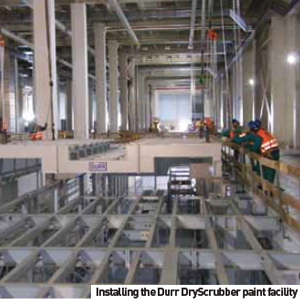 The assembly line at Kecskemét will be arranged in a ‘T’ formation, which in of itself is a solution developed from looking at past assembly lines. “In older plants, we have had issues with handling growing model complexity. Here, we have a logistics concept that has four suppliers in the assembly hall, with another six located adjacent to the plant.”
The assembly line at Kecskemét will be arranged in a ‘T’ formation, which in of itself is a solution developed from looking at past assembly lines. “In older plants, we have had issues with handling growing model complexity. Here, we have a logistics concept that has four suppliers in the assembly hall, with another six located adjacent to the plant.”
Klein points out of the window at an area across from the container offices, where the first supplier park buildings are starting to take shape. “That is Supplier Park 2 and inside the assembly hall is Supplier Park 1. This is a concept developed from our experiences with other plants.”
Klein says that the buildings in the outside supplier park will be owned by Mercedes-Benz and leased to the selected suppliers. “I think this is very important. It gives us flexibility. I wouldn’t want to have a supplier on our site operating on their own.” He says that as contracts are still being finalized the suppliers cannot be named, but puts forward other details. “What I can say is that we have 17 suppliers that are based in Hungary, and we are anticipating between 30 and 40 suppliers moving into the region. Ten of these will be at the plant.”
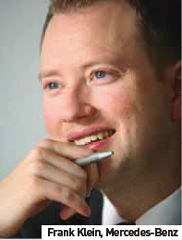 In February 2010, Klein was appointed project leader in charge of setting up the new Mercedes-Benz plant in Kecskemét, Hungary, and he will also be plant manager at the new facility. Here, we outline his educational and professional background.
In February 2010, Klein was appointed project leader in charge of setting up the new Mercedes-Benz plant in Kecskemét, Hungary, and he will also be plant manager at the new facility. Here, we outline his educational and professional background.
Born in Mainz, Germany, in 1972, Klein studied electrical engineering at the Berufsakademie (college of advanced vocational studies) in Stuttgart. In 1994, he joined the former Daimler-Benz AG as a bodyshell engineer. He is married with two children
The identity of equipment suppliers is more readily available. As Klein says, Mercedes counts on the same companies to deliver equipment in Germany and all over the world. Siemens, Dürr and Kuka feature prominently, which is no surprise, each being traditional Mercedes-Benz partners.
What is noteworthy is the equipment they are providing. In the case of Dürr, the company has supplied its latest tech, details of which are outlined by Dr. Rolf Windisch, Director of Factory Planning (Passenger Cars). “The paintshop features the latest ‘DryScrubber’ technology, which is being installed by Dürr and Eisenmann. It is one of the biggest things here, in terms of new technology. It can reduce energy costs in the spray booth area by about 60%.”
As for welding robots, Mercedes has elected to take an unusual route with the equipment scheduled for installation at Kecskemét. Frank Klein: “We have completed an interesting ‘reuse’ project, where we have taken robots that have been welding E-Class bodies for the past eight years, but over the transition from old to new model, have needed to be replaced. The 500 robots we will use have been reconditioned over the last 12 months, using industrystandard technology.”
While the majority of buildings at Kecskemét are nearing completion, the press shop is still in its initial build stages. This is because it is scheduled to only start providing panels for the second of the new models due to enter series production. “As the press shop is only designed to provide parts for the second model, it’s a little behind the other site structures. It’s not behind schedule, it’s a planned part of the build sequence,” says Klein.
October 2007 to January 2010 –
Head of Assembly: S-Class, CL-Class, Maybach, SLS AMG, Guard, Pullmann, B-Class fuel cell, seat production, and engine pre-assembly - Daimler AG, Sindelfingen
2005 - Executive assistant to the Chief Operating Officer of Mercedes- Benz Cars - Daimler AG, Stuttgart
2004 - Head of assembly and bodyshell CL-Class - DaimlerChrysler AG, Sindelfingen
2002 - Head of electrics & electronics assembly - DaimlerChrysler AG, Sindelfingen
1999 - Executive assistant to the Head of Vehicle Research of Mercedes-Benz Cars - DaimlerChrysler AG, Stuttgart
1996 - Head of Electric & Electronic Tools and Processes - Daimler- Benz AG, Freightliner, Portland (USA)
1994 - Bodyshell engineer - Daimler-Benz AG, Sindelfingen
Body pressings for the first model will be delivered from a series of plants including Bremen and Kuppenheim, the latter having undergone a €70m upgrade completed over 2010. Most parts, says Klein, will be delivered from Sindelfingen. “Part delivery is one of the main reasons we needed the rail connection, it’s very important in terms of logistics.” The spur line will both serve as a part supply method and also a distribution route for finished vehicles, 50% of which will be shipped by train. “In the plant we have over 9km of track; it was part of the planning process. It was also one of the main reasons for selecting this site, we only needed 900m of track to get into the plant.”
Most tooling for the press shop has already been crafted at Sindelfingen; the facility has a dedicated group for development and delivery of these products, while tooling and production of smaller parts has been contracted out to individual suppliers. By the time the second model enters production at Kecskemét, Klein says that by there will be two press lines, one large and one small, delivering the A1-level parts crucial for maintaining exterior quality.
The press tooling that will be used at the plant has already entered the testing phase at Sindelfingen, with the panels going on for use in BIW tests. “Part of the bodyshop line has been set up for testing and we have already made the first bodyshells,” says Klein. Once testing is complete, the BIW assembly line will be dismantled and shipped to Kecskemét for final installation.
Once both models are in production, the weldshop will remain a single production line; like most Mercedes-Benz plants, the bodyshop will be 100% automated. Does the heavy use of robotics miss out on one of the key benefits of being in Hungary, the availability of comparatively cheap labour? “When you make development decisions, you have to balance labour costs and capital investment,” says Klein.
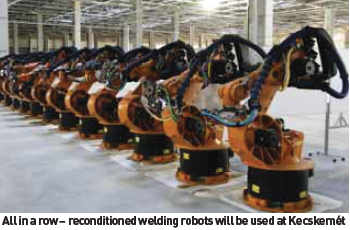 “But as we are building in standard processes and standard assembly lines, we will follow standard patterns. You need this if you’re going to put out top quality five-days per week. There are some areas where we decided to have a process completed manually, but it’s minimal.”
“But as we are building in standard processes and standard assembly lines, we will follow standard patterns. You need this if you’re going to put out top quality five-days per week. There are some areas where we decided to have a process completed manually, but it’s minimal.”
Asked if the bodyshop features any high technology in terms of welding, such as laser brazing, Klein’s reply underlines the now mainstream nature of what once were rarely-used techniques. “There will be a lot of spot welding, but we will also have laser welding. I would say that’s already a standard in the industry. We have that and all the other standard welding processes that you find elsewhere in the industry.”
Adhesives will also feature in BIW; use of the joining method is on the increase across all Mercedes-Benz models.
“In order to meet expected safety, comfort and stability levels, the (joining) techniques that we use on other models will be used here, including adhesives.”
The question, though, is why Hungary. Why not Poland or the Czech Republic? All local and national governments are prepared to offer tax breaks in order to win the massive number of jobs that a new car plant represents, but above and beyond these, what was it about Hungary that prompted Mercedes-Benz to build in Kecskemet?
“We looked at several locations during the site selection process, across Europe we had a long evaluation process,” says Klein. “I cannot share each of the criteria, but Hungary was able to offer us a good location, highly-qualified people, which was one of the crucial areas. Overall, it was a combination of a lot of different factors, including personnel costs, build quality, the supplier base. To date, 17 Hungarian suppliers have been awarded part delivery contracts. We are also forecasting a dramatic increase in sales volumes in the (premium compact) segment in Eastern Europe. All these factors were brought together and Hungary was the final candidate.”
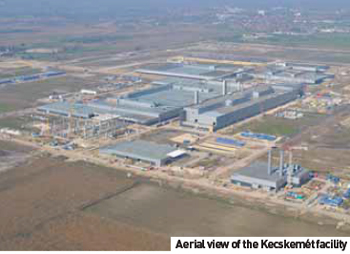 For Mercedes, Hungary offered the right mix of people and suppliers for a premium carmaker, but the fact of the matter is that small cars mean small margins. Does the Hungarian location help to build profit into the car as it can be produced here at a lower cost in comparison to other locations?
For Mercedes, Hungary offered the right mix of people and suppliers for a premium carmaker, but the fact of the matter is that small cars mean small margins. Does the Hungarian location help to build profit into the car as it can be produced here at a lower cost in comparison to other locations?
“We were not able to expand Rastatt like we would have needed to,” says Klein. With regards to why, Dr. Windisch takes up the story. “Rastatt has a maximum annual capacity of 250,000 units. If you expand that to 400,000 units, it creates a lot of challenges with regards to logistics. We already run a very complex part delivery system to support increased vehicle complexity. To help with this, we try to limit production at individual plants to suit the technical capacity, about 250,000upa – this is a good size, both in terms of logistics and the environment.”
Klein: “When you’re presented with the opportunity to build a new plant, you also have a range of alternatives. Coming to Hungary has given us alternative logistics costs, and we have the right people who can build quality. Personnel, though, are only one of several factors. We must have an effective and cost-efficient production system that can provide cars to the segment at a price that customers are willing to pay.”
More than 150 engineers, architects, geologists and equipment planning engineers have been involved with the development of the Kecskemét site since the site was signed off in 2008. The first step beyond the planning phase was site levelling, which Dr. Rolf Windisch says involved the redistribution of 2.5 million cubic metres of earth – 250,000 truck loads – across the site in order to create a median level. He adds that no material was moved off-site during the process. “The quality of the ground structure is one of the main reasons why we selected this site.”
The site’s natural drainage qualities are another aspect that make it ideal for plant construction. “During the site selection process, we were presented with some sites that had standing water on them, which is not at all suitable,” says Windisch. “Here, we simply had to install a drainage system and build a pond to hold the water run-off. This is just for rainwater, it’s not used in the water recycling process for the paintshop.” An on-site water treatment facility will handle the waste water produced by the DryScrubber paintshop technology.
Once the levelling and drainage installations were complete, concrete was poured into approximately 2,000 bore holes, which combined with steel ribar created the pillars required to stabilize the ground under the press and paintshop buildings. “Each building has a foundation to suit the activity carried out there, but the press shop requires an extra-heavy foundation,” says Windisch.
Construction of the bodyshop incorporates the support pillars and a 22cm-deep foundation slab. The internal pillars are arranged on this in a grid pattern measuring 18m x 18m.
The wall sections are hung on the exterior pillars, but slightly off the floor slab in order to reduce condensation build up. Made from steel and insulation material, do the wall sections require additional insulation to deal with Hungarian winter temperatures? “The amount of insulation is optimised. It’s not like a home, that you have to heat to make it liveable.
In each of the shops, heat is developed as a by-product of the processes. So in reality, you have to concentrate on removing heat from the building. This is how we optimise the buildings, balancing how much heat must be added in the winter and removed in the summer.”
While most energy for the plant is taken from the grid, the Kecskemét site further features its own power plant, developed through co-operation between Hungarian and German suppliers. The power plant, which provides sufficient energy to keep the on-site systems ticking over, but not enough to support operational activities, primarily supports heating and cooling functions. Windisch says that where possible, heat recovery systems have been incorporated into the HVAC system, with each component section reviewed to determine its recovery potential. This includes the system that will deliver six bar of compressed air for tooling on the assembly line. “We need (compressed air) for several processes, but we’re also planning to have a lot electrical equipment on the line. Compressed air is a very expensive energy, so we have tried to limit its use as much as possible.”
“We are always looking for energy efficiency at all our plants, both new and existing, but of course, it’s much more expensive to switch or upgrade to new systems in existing plants rather than at new plants such as this,” says Dr. Rolf Windisch. “At plants such as this, you pay for the technology, but only to purchase and install; there’s no added complication involving removal and installation of the updated systems.”
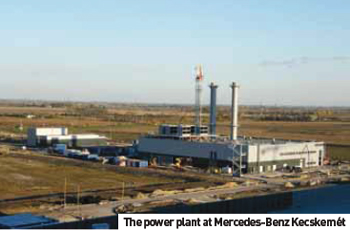 A series of energy-saving technologies have been planned for the new plant, which include the combined power supply, plus rotary heat recovery systems and high efficiency lighting. Windisch says that each on-site structure has been looked at with regards to savings potential; the administration building is considered ‘green’, in that it uses 25% less energy than an equivalent office block. Beyond this, the overall production process has been reviewed with the goal of reducing energy consumption. “A plant uses about 60% of the energy used when it is producing cars just to keep ticking over, so we have developed systems that can be shut down in order to save energy when the plant is not in operation.”
A series of energy-saving technologies have been planned for the new plant, which include the combined power supply, plus rotary heat recovery systems and high efficiency lighting. Windisch says that each on-site structure has been looked at with regards to savings potential; the administration building is considered ‘green’, in that it uses 25% less energy than an equivalent office block. Beyond this, the overall production process has been reviewed with the goal of reducing energy consumption. “A plant uses about 60% of the energy used when it is producing cars just to keep ticking over, so we have developed systems that can be shut down in order to save energy when the plant is not in operation.”
Audi has announced plans to plant 100,000 trees at each facility in order to off-set CO2 output. Has Mercedes-Benz considered doing the same in order to reduce the carbon footprint of this and other plants? Windisch: “From our point of view, shutting down energy systems is a far more efficient way to reduce CO2 output. One tree saves about 0.1kg of CO2 per year. At Mercedes, we have reduced the average annual CO2 output by 170,000 tonnes over the last two years, with a further reduction potential of 190,000 tonnes per year.” He adds that the plant does not have any recycling or recapture systems for CO2 emissions. Instead, the goal is to simply reduce emissions at source. Moving finished vehicles by train instead of by road will cut CO2 emissions by an estimated 60,000 tonnes per year.
Mercedes-Benz Hungary (Kecskemét)
Investment total: €800m (approx.)
Site: 440 hectares (4.4m m2)
Steel usage: 35,000 tonnes (approx.) (4.8 Eiffel towers)
Concrete: 160,000m3 (18,000 trucks)
Waste: 260km supply and disposal circuits
Is the plan to increase Mercedes’ compact car range an attempt to reduce the carmaker’s CO2 fleet footprint? “The main motivation is to supply a growing segment.
For example, people who otherwise might not consider the Mercedes brand might choose one of these cars, or an S-Class customer may want a second small car of comparable quality. With regards to the S-Class, we have introduced a range of efficient diesel engines and a new hybrid engine. We will address reduction of fleet emissions across our model ranges, not by segment.”
Windisch describes the paintshop roof at Kecskemét, constructed using steel and two layers of moisture-resistant material, as ‘absolutely standard’. But it is such carry-overs as this that have allowed site contractors, 80% of which are Hungarian, to reach such an advanced point in the build phase only 12 months after site levelling was completed.
While mention of such standard elements could imply that little thought has been given to incorporating new technologies at the plant, it’s clearly not the case, as other non-standard features are widely distributed across the various buildings.
“Installing elements like the advanced paintshop and other production systems that can be switched on and off as you need them, can save a lot of energy. I think that as energy prices increase, we need to look at reducing power consumption rather than reducing emissions. Cut power usage and naturally, there will be less CO2 output.”































